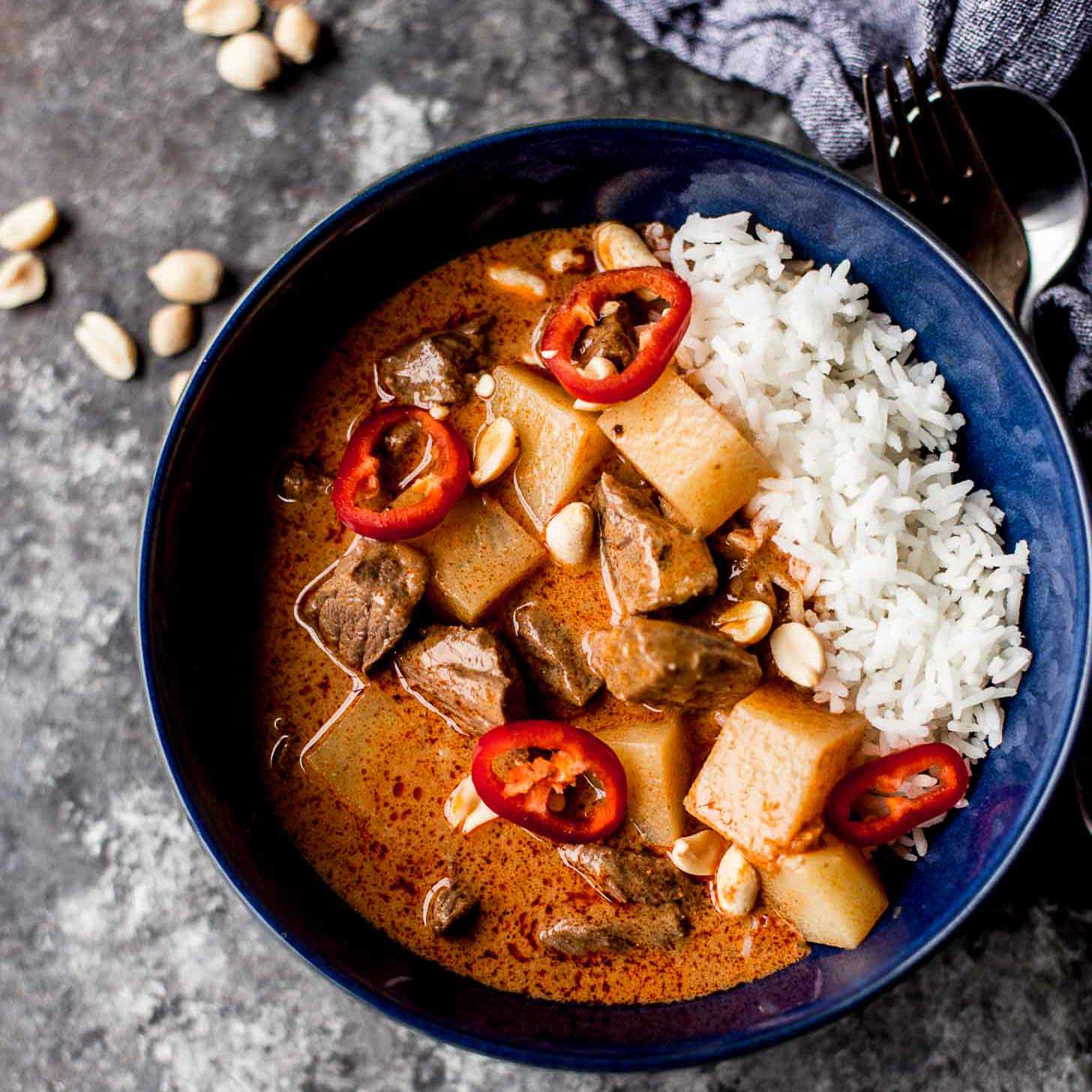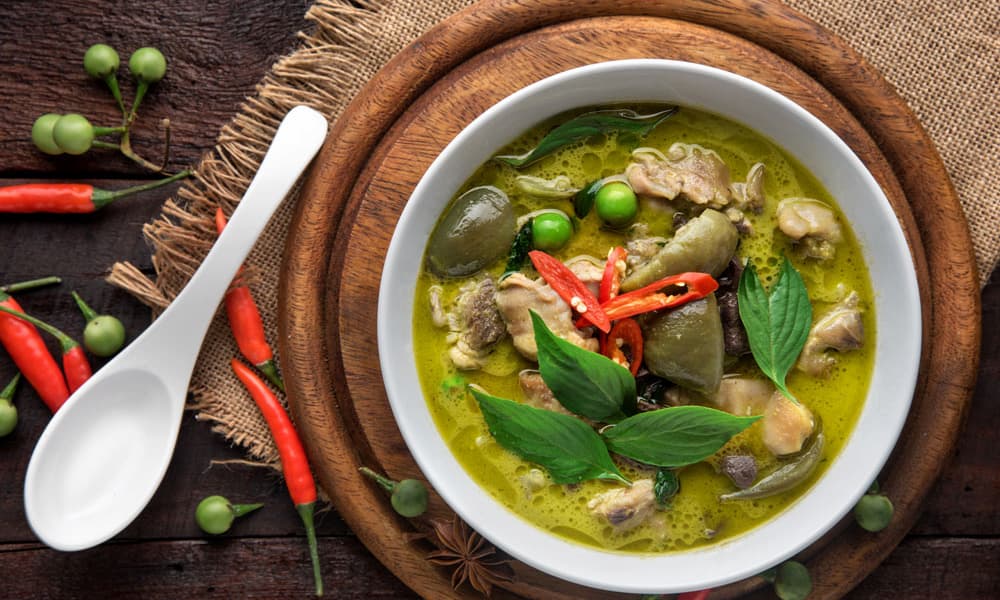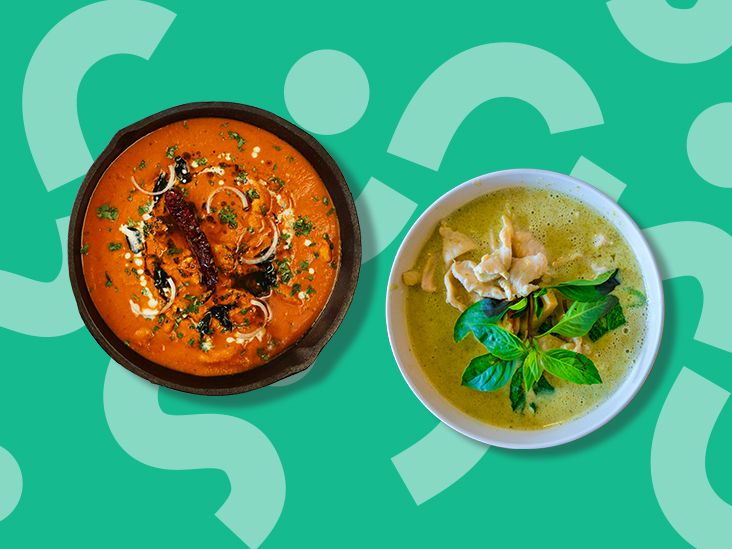
Introduction
Overview Of Thai Curries
Thai cuisine is known for its rich and flavorful curries. These curries are made with a variety of ingredients, including aromatic herbs and spices. Three popular types of Thai curries are red, yellow, and green curry. Each curry has its own distinct flavor and level of spiciness.
Importance Of Understanding The Differences Between Red And Yellow Curry
It is important to understand the differences between red and yellow curry as they can greatly affect the taste and spiciness of a dish. Knowing which curry to use in a recipe can help you create a well-balanced and delicious Thai dish.
Comparing Red, Yellow, and Green Curry:
| Curry Type | Color | Spiciness | Ingredients |
|---|---|---|---|
| Red Curry | Red | Fiery hot | Red chilies |
| Yellow Curry | Yellow | Moderate | Yellow chilies |
| Green Curry | Green | Mild | Green chilies |
In terms of spiciness, red curry is the hottest of the three, with a fiery and intense flavor. Green curry is milder, offering a balanced and refreshing taste. Yellow curry falls in between the two, providing a moderate level of spiciness.
The choice of chilies used in each curry also contributes to their different flavors. Red curry is made with red chilies, which have a robust, earthy taste. Green curry, on the other hand, is made with green chilies, which have a brighter and slightly sweeter flavor. Yellow curry uses yellow chilies, which have a milder and more subtle taste compared to red or green chilies.
Understanding the differences between red and yellow curry allows you to select the right curry for your desired level of spiciness and flavor. Whether you prefer a fiery hot dish or a milder option, Thai curries offer a wide range of flavors and heat levels to suit various palates.
What Is Red Curry?
Ingredients And Flavors Of Red Curry
Red curry is a popular Thai curry known for its fiery and intense flavor. It is made with a variety of ingredients, including red chilies, which give it its distinct red color. Other common ingredients in red curry include lemongrass, garlic, shallots, galangal, shrimp paste, and various spices like coriander and cumin. The combination of these ingredients creates a rich and complex flavor profile.
Heat Level And Spiciness Of Red Curry
Red curry is the hottest of the three Thai curries. The red chilies used in red curry are known for their high level of spiciness, which contributes to the intense heat of the dish. However, the spiciness of red curry can vary depending on the specific recipe and the amount of chilies used. Some variations of red curry may be milder, while others can be extremely hot. It is important to be mindful of the spiciness level when ordering or cooking with red curry if you are not accustomed to spicy foods.
Understanding the characteristics of red curry, such as its ingredients, flavor, and spiciness, can help you make an informed decision when choosing a Thai curry. If you enjoy bold and fiery flavors and can handle the heat, red curry is a great choice. However, if you prefer a milder or less spicy option, there are other Thai curry variations, such as yellow and green curry, that may better suit your taste preferences.
What Is Yellow Curry?
The Yellow curry is another popular Thai curry that offers a milder and more subtle flavor compared to the red curry. Let’s take a closer look at the ingredients, flavors, and spiciness level of yellow curry.
Ingredients And Flavors Of Yellow Curry
Yellow curry gets its vibrant color from the turmeric used in its preparation. Along with turmeric, yellow curry typically includes other fragrant ingredients like lemongrass, ginger, garlic, shallots, and coriander seeds. These ingredients come together to create a warm and aromatic flavor profile. Yellow curry is often compared to Indian curry due to its use of turmeric and spices, but it has its distinct Thai twist.
Heat Level And Spiciness Of Yellow Curry
When it comes to spiciness, yellow curry falls on the milder side of the spectrum. It is generally less spicy compared to red curry, making it a suitable option for those who prefer a more gentle heat. However, it’s important to note that the spiciness of yellow curry can still vary depending on the recipe or the region of Thailand.
While yellow curry may not pack as much heat as its red counterpart, it still delivers a delightful blend of flavors. Its balanced and mild spiciness makes it a great choice for those who want to enjoy the essence of Thai cuisine without being overwhelmed by spiciness.
In conclusion, yellow curry offers a milder and more subtle flavor compared to red curry. It combines fragrant ingredients like turmeric, lemongrass, and coriander seeds to create a warm and aromatic flavor profile. While it is not as spicy as red curry, yellow curry still delivers a delightful blend of flavors. So, if you prefer a milder option with a touch of spice, yellow curry is a great choice.

Key Differences Between Red And Yellow Curry
Color, Aroma, And Appearance
- Red curry gets its vibrant red color from multiple red chilies, giving it a fiery appearance. The aroma of red curry is bold and spicy.- Yellow curry, on the other hand, gets its distinct yellow color from turmeric. It has a more subtle appearance compared to red curry. The aroma of yellow curry is warm and aromatic.
Main Ingredients And Flavor Profiles
- Red curry is made with several red chilies, which contribute to its spiciness. Other common ingredients in red curry include garlic, shallots, lemongrass, and Thai basil. The flavor profile of red curry is bold, spicy, and rich.
- Yellow curry includes turmeric as the main ingredient, along with fragrant ingredients like lemongrass, ginger, garlic, shallots, and coriander seeds. The flavor profile of yellow curry is milder and more subtle compared to red curry. It offers a delicate balance of flavors.
- While red curry is known for its fiery heat, yellow curry falls on the milder side of the spiciness spectrum. It is generally less spicy compared to red curry, making it a suitable choice for those who prefer a more gentle heat.
To summarize, the key differences between red and yellow curry lie in their color, spiciness, and flavor profiles. Red curry is fiery and bold, thanks to the use of red chilies, while yellow curry has a more subtle appearance and a milder heat level. Each curry offers its distinct flavors and is a delightful choice for Thai cuisine enthusiasts.
Regional Variations
One interesting aspect of Thai curries is that their flavors and spiciness can vary based on the region of Thailand they originate from. Here are some notable differences in regional variations:
Differences In Spiciness Based On Region
- Southern Thai curries are often the spiciest, with red curry being particularly fiery. The use of bird’s eye chili peppers contributes to the intense heat in these curries.- Central Thai curries, on the other hand, tend to have a more balanced spiciness. Red curry is still quite hot, but it is milder compared to the southern style. Yellow curry in the central region also leans towards a milder spice level.- Northern Thai curries are known for their unique flavor profiles and are less spicy compared to southern and central curries. The spice level in red curry is toned down, making it more accessible to those who prefer a milder heat.
Popular Regions Known For Their Unique Curry Variations
- Chiang Mai, in northern Thailand, is famous for its Khao Soi curry. This curry combines elements of both red and yellow curry, resulting in a rich and creamy dish topped with crispy noodles.- Southern Thailand is renowned for its Gaeng Tai Pla curry, which features a potent combination of spicy flavors from various chili peppers, shrimp paste, and fish.- Bangkok, the capital city, is known for its Panang curry. This curry has a slightly sweeter and nuttier flavor compared to other Thai curries, and it is usually made with beef or chicken.
Whether you prefer a fiery, medium-hot, or milder curry, Thai cuisine has something to offer for every palate. The variation in colors, flavors, and levels of spiciness make Thai curries a delightful choice for those who enjoy exploring different culinary experiences. By understanding the differences between red, yellow, and green curries and the regional variations, you can enhance your Thai cuisine knowledge and savor the rich flavors of this popular cuisine.
Taste And Versatility
Flavor Comparisons Between Red And Yellow Curry
Red curry, typically made with red chilies, is known for its fiery and intense heat. The spiciness of red curry can vary based on the region it originates from, with Southern Thai red curry being the hottest. In contrast, yellow curry tends to have a milder and more balanced spice level. Yellow curry is often made with turmeric, giving it a vibrant yellow color and a slightly earthy flavor. The use of spices like cumin and coriander also adds depth to yellow curry.
Dish Recommendations For Each Curry
- Red curry: Due to its bold and spicy flavors, red curry pairs well with rich and hearty ingredients like beef, pork, or duck. It’s commonly used in dishes like red curry with chicken, red curry beef stir-fry, or red curry with roasted duck.- Yellow curry: Yellow curry’s milder spice profile makes it versatile and suitable for a variety of ingredients. It is often used in vegetarian or seafood dishes, such as yellow curry with tofu and vegetables or yellow curry shrimp. The creamy and fragrant nature of yellow curry also complements poultry dishes like yellow curry chicken.- Green curry: Green curry, made with green chilies, has a fresh and vibrant flavor. It pairs well with ingredients like chicken, shrimp, or vegetables. Popular dishes include green curry chicken, green curry shrimp, or green curry with tofu and eggplant. The aromatic notes of Thai basil and kaffir lime leaves add a unique touch to green curry dishes.
Thai curries are a delightful culinary experience, offering a range of flavors and spice levels to suit different preferences. Whether you prefer fiery heat, a milder touch, or a balance of flavors, exploring the different curry variations allows you to appreciate the diversity of Thai cuisine.

Which Curry Should You Choose?
Factors To Consider When Choosing Between Red And Yellow Curry
When deciding between red and yellow curry, it’s important to consider your spice tolerance and flavor preferences. Here are some factors to keep in mind:- Spice level: If you enjoy a spicy kick, opt for red curry, which is known for its fiery heat. However, if you prefer a milder spice level, yellow curry is the better choice.- Flavor profile: Red curry offers a bold and intense flavor, while yellow curry has a more balanced and slightly earthy taste. Consider which flavor profile appeals to you more.- Dish recommendations: Think about the specific dish you want to order. Certain ingredients pair better with red curry, such as beef, pork, or duck, while yellow curry is versatile and works well with a variety of ingredients like tofu, vegetables, or seafood.
Personal Preferences And Recommendations
If you’re a spice fan and love bold flavors, go for the red curry. It will provide a fiery and exhilarating experience. Pair it with rich meats like beef or duck for a hearty and satisfying meal.On the other hand, if you prefer a milder spice level or are new to Thai cuisine, the yellow curry is a safe choice. Its vibrant yellow color and balanced flavors make it an enjoyable option for those who are not accustomed to intense heat. Try it with tofu and vegetables for a vegetarian-friendly dish or with shrimp for a seafood twist.
Ultimately, the choice between red and yellow curry depends on your personal preferences and spice tolerance. Don’t be afraid to experiment and try different Thai curries to discover your favorite. Thai cuisine offers a wide range of flavors and spice levels, ensuring there’s something for everyone to enjoy. So whether you’re seeking a fiery kick or a milder touch, Thai curries are a delightful culinary adventure that should not be missed.
Benefits Of Thai Curries
Nutritional Value And Health Benefits
Thai curries are not only delicious, but they also offer several health benefits. Here are some nutritional highlights:
- Vegetables: Thai curries are typically loaded with an array of colorful vegetables, such as bell peppers, broccoli, carrots, and green beans. These vegetables are rich in vitamins, minerals, and fiber, contributing to a well-rounded and nutritious meal.
- Protein: Whether you choose to add tofu, chicken, beef, or seafood, Thai curries provide a good source of protein. Protein is essential for muscle growth and repair, as well as maintaining a healthy immune system.
Additionally, the herbs and spices used in Thai curries, such as lemongrass, ginger, garlic, and chili peppers, offer potential health benefits. For example:
- Lemongrass has antibacterial and antioxidant properties and may help alleviate digestive issues.
- Ginger has anti-inflammatory properties and may aid in digestion and reduce nausea.
- Garlic is known for its immune-boosting properties and may help lower blood pressure and cholesterol levels.
- Chili peppers contain capsaicin, which has been linked to weight management, reduced inflammation, and improved heart health.
Cultural Significance And Culinary Traditions
Thai curries hold significant cultural importance and are a staple in Thai cuisine. Here are some key aspects of their culinary traditions:
- Balance of flavors: Thai curries are known for their perfect balance of sweet, spicy, savory, and sour flavors. This harmonious blend is achieved through the combination of ingredients like curry paste, coconut milk, fish sauce, lime juice, and palm sugar.
- Traditional preparation: Thai curries typically involve pounding fresh ingredients using a mortar and pestle to make the curry paste. This labor-intensive technique ensures the flavors are fully extracted and results in a depth of taste that cannot be replicated.
- Regional variations: While red, green, and yellow curries are the most well-known, Thai cuisine features a wide range of regional curry variations. For example, Massaman curry from Southern Thailand is rich and fragrant, while Panang curry from Central Thailand is creamy and slightly sweet.
In conclusion, Thai curries not only offer a delicious dining experience but also provide numerous health benefits. Their nutritious ingredients and traditional preparation methods make them a popular choice for those seeking a flavorful and wholesome meal. Whether you’re enjoying the fiery heat of red curry or the milder touch of yellow curry, Thai curries are a culinary delight that celebrate the rich heritage and flavors of Thailand.
Benefits Of Thai Curries
Nutritional Value And Health Benefits
Thai curries offer not only delicious flavors but also several health benefits. Some key nutritional highlights include:
- Vegetables: Thai curries are typically loaded with an array of colorful vegetables such as bell peppers, broccoli, carrots, and green beans. These vegetables are rich in vitamins, minerals, and fiber, making the curry a well-rounded and nutritious meal.
- Protein: Thai curries can be customized with various protein options such as tofu, chicken, beef, or seafood. They provide a good source of protein, which is essential for muscle growth, repair, and maintaining a healthy immune system.
Additionally, the herbs and spices used in Thai curries offer potential health benefits. For example:
- Lemongrass has antibacterial and antioxidant properties and may help alleviate digestive issues.
- Ginger has anti-inflammatory properties and may aid in digestion and reduce nausea.
- Garlic is known for its immune-boosting properties and may help lower blood pressure and cholesterol levels.
- Chili peppers contain capsaicin, which has been linked to weight management, reduced inflammation, and improved heart health.
Cultural Significance And Culinary Traditions
Thai curries hold significant cultural importance and are a staple in Thai cuisine. Some key aspects of their culinary traditions include:
- Balance of flavors: Thai curries are known for their perfect balance of sweet, spicy, savory, and sour flavors. This harmonious blend is achieved through the combination of ingredients like curry paste, coconut milk, fish sauce, lime juice, and palm sugar.
- Traditional preparation: Thai curries typically involve pounding fresh ingredients using a mortar and pestle to make the curry paste. This labor-intensive technique ensures the flavors are fully extracted and results in a depth of taste that cannot be replicated.
- Regional variations: While red, green, and yellow curries are the most well-known, Thai cuisine features a wide range of regional curry variations. For example, Massaman curry from Southern Thailand is rich and fragrant, while Panang curry from Central Thailand is creamy and slightly sweet.
Conclusion
Recap Of Key Points
To summarize, Thai curries offer a flavorful and wholesome dining experience while providing numerous health benefits. These include the nutritious ingredients such as vegetables and protein, as well as the potential health benefits of the herbs and spices used in the curries. Additionally, Thai curries are deeply rooted in Thai culinary traditions, with their balance of flavors and traditional preparation methods.
Final Thoughts And Takeaway For Curry Lovers
For curry lovers, Thai curries are a culinary delight that celebrate the rich heritage and flavors of Thailand. Whether you prefer the fiery heat of red curry or the milder touch of yellow curry, Thai curries offer a delightful gastronomic experience. Enjoy the array of vegetables, the choice of protein, and the unique blend of flavors that Thai curries bring to the table.
FAQ: Red Curry vs Yellow Curry: A Spicy Showdown
Q: What is the main difference between red curry and yellow curry?
A: The main difference between red curry and yellow curry lies in their color and flavor profile. While red curry is known for its fiery spiciness and vibrant red hue, yellow curry features a milder taste with a sunny yellow appearance.
Q: Are the ingredients used in red curry and yellow curry different?
A: Yes, the ingredients used in red curry and yellow curry differ to a certain extent. Red curry is traditionally made using red chili peppers, garlic, shallots, lemongrass, galangal, and spices like coriander, cumin, and shrimp paste. On the other hand, yellow curry incorporates yellow curry powder, which consists of ingredients such as turmeric, cumin, coriander, fenugreek, and mustard.
Q: Which curry is spicier, red or yellow?
A: Red curry is typically spicier than yellow curry. The red chili peppers used in red curry give it a fiery kick that can make your taste buds tingle. Meanwhile, yellow curry tends to have a milder, gentler heat, making it more approachable for those who prefer a less fiery culinary experience.
Q: Do the flavors of red curry and yellow curry differ?
A: Yes, the flavors of red curry and yellow curry have their own distinct characteristics. Red curry offers a robust and complex flavor profile with hints of spiciness and a slightly sweet undertone. Yellow curry, on the other hand, has a more mild and aromatic taste, often featuring a delicate balance of tangy, nutty, and earthy flavors.
Q: Can I customize the level of spiciness in red curry and yellow curry?
A: Absolutely! The spiciness of both red curry and yellow curry can be adjusted according to personal preferences. If you prefer a milder version, you can reduce or omit the amounts of chili peppers or curry powder used. Conversely, if you’re a fan of intense heat, feel free to add more chili peppers or curry powder.
Q: Are there any specific dishes that are commonly made with red curry or yellow curry?
A: Yes, there are! Red curry is often used in popular Thai dishes such as red curry chicken, red curry shrimp, and red curry beef. Yellow curry, on the other hand, is commonly utilized in dishes like yellow curry with potatoes, yellow curry with chicken or tofu, and yellow curry with vegetables.
Q: Does the choice between red curry and yellow curry depend on personal preference?
A: Absolutely! The choice between red curry and yellow curry ultimately depends on your personal preferences for spiciness and flavor. If you enjoy a fiery kick and bold flavors, red curry might be the way to go. On the other hand, if you prefer a more mellow and aromatic taste, yellow curry could be your best bet.
Please note that the flavor and spiciness levels of red curry and yellow curry may vary slightly depending on regional variations and personal adaptations.

We are a small takeaway restaurant offering a great selection of food cooked by our Thai chef. Table spaces are limited, so please book in advance.